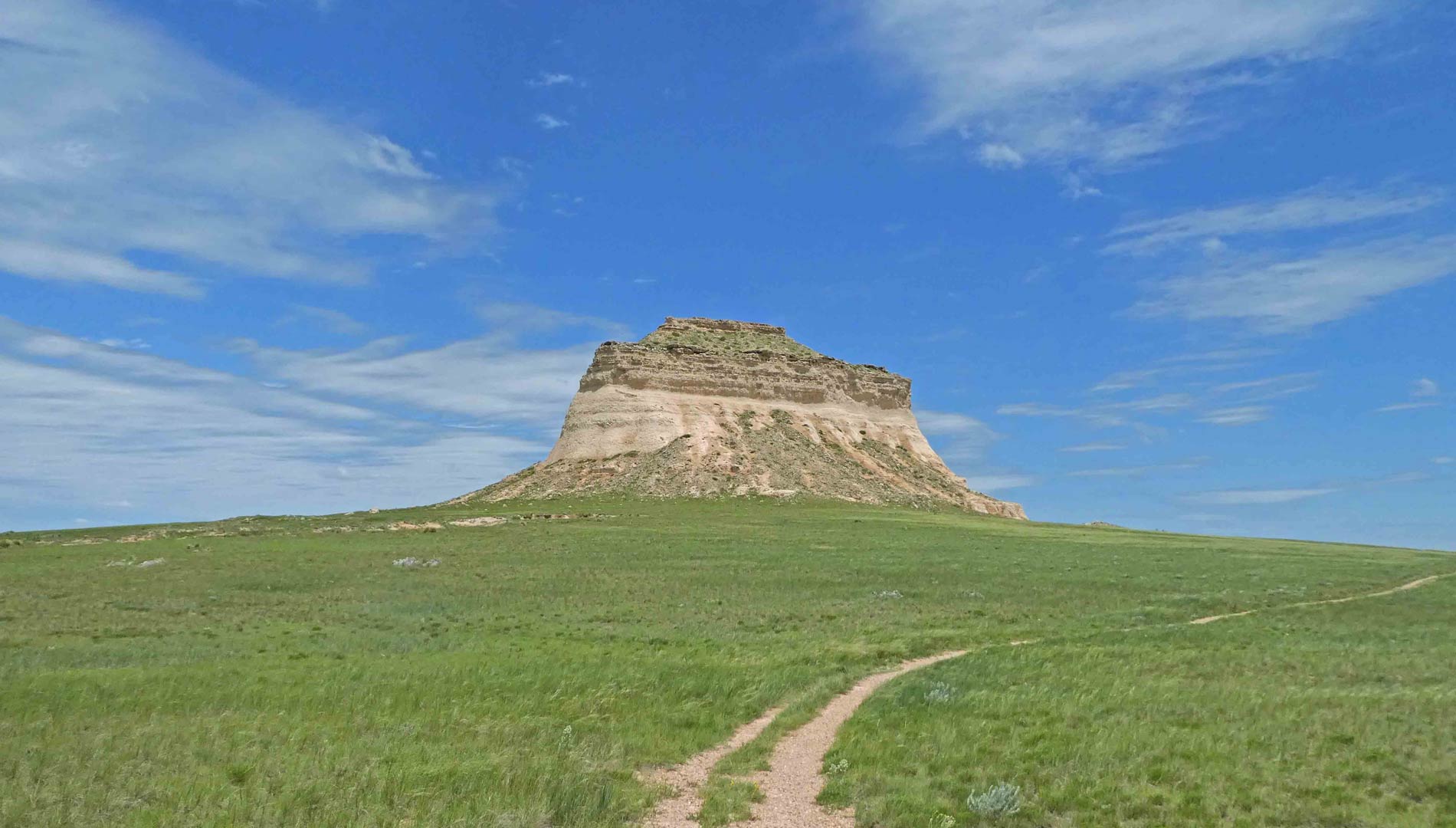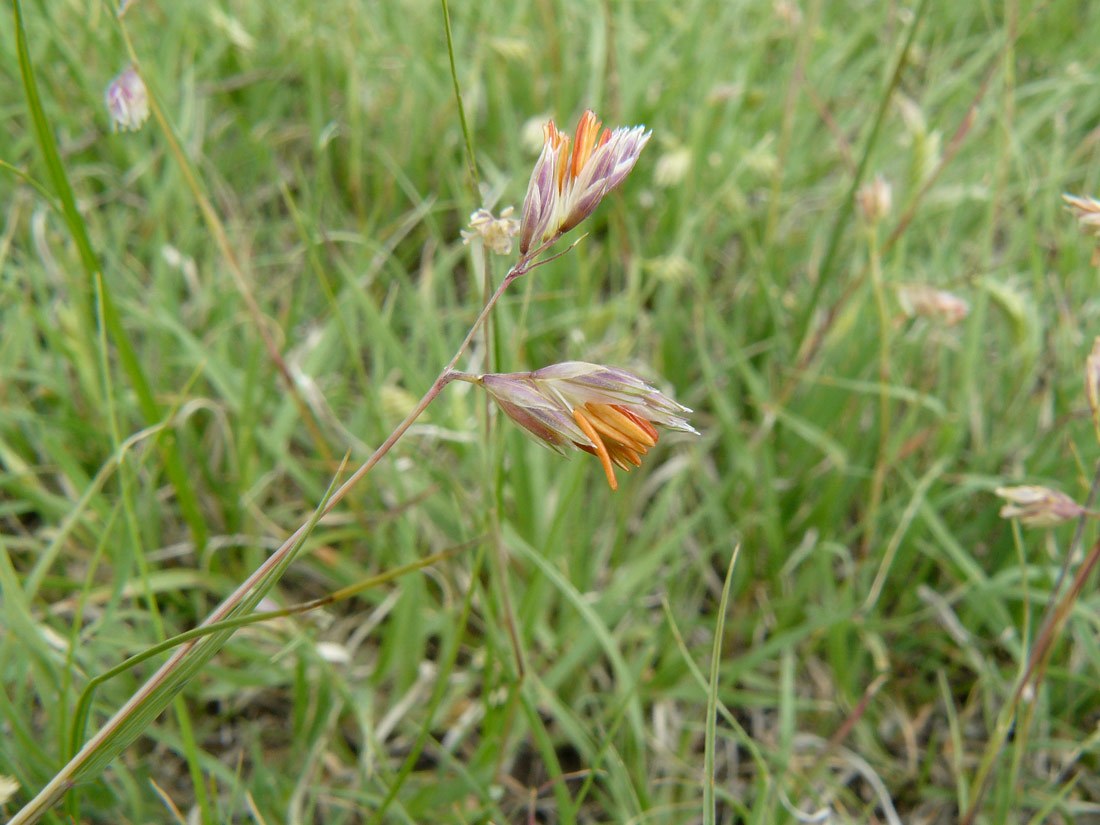Western Great Plains Shortgrass Prairie
Pawnee Buttes National Grassland, Weld County
Shortgrass Prairie
The shortgrass prairie occurs on the eastern plains of Colorado from the foothills to the eastern border in Nebraska and Kansas and the Oklahoma panhandle. The vast majority of this area is grasslands, and 95% of these grasslands are shortgrass prairie. Shortgrass prairie consists of two grasses that grow ankle-high, whereas the other two types of grasslands are midgrass prairie, where the grass species grow knee-high and tallgrass prairie where the grass species grow to waist- or shoulder height.
The eastern plains are quite dry, receiving only 15-20 inches of precipitation per year in the eastern-most areas and slightly less (10-15 inches) in a narrow strip along the edge of the mountains. On the plains, the greater part of the annual precipitation occurs at the beginning of the growing season in April, May and June, resulting in more verdant vegetation than one would expect for such low annual precipitation rates. However, the “wet” season is short with drought usually following resulting in accelerated growth of species in the Spring followed by the growth of more xerophytic species like composites (asters) in the rest of the summer.
Another noticeable feature of the eastern great plains is the absence of trees. Climate has a lot to do with this. The seasonal distribution of precipitation leads to to the absence of snow in the winter resulting in low soil moisture which makes it difficult for trees to survive. In addition the plains have larger daily and yearly ranges in temperatures than foothill, montane and subalpine areas where most of our forests are found. Combined low annual precipitation with low humidity and dry winds and the result is grasslands rather than forests or savanna.
The eastern great plains of Colorado are classified as “open steppe” and at first seem featureless. But look more closely and you will find a matrix system of habitats dominated by Blue Gramma (Boutloua gracilis) growing on rolling to flat topography with occasional dramatic buttes and canyons with a variety of soil substrates.
Some Commonly Associated Plants
Click on photo to see full-page lightbox image.
In lightbox, click on X in upper right corner to return here.
Buffalo Grass (Buchloe dactyloides)
Buffalo Grass (Buchloe dactyloides), Grass Family (Poaceae), native and common in the shortgrass prairie and foothills, sometimes grown as a lawn grass, from plains to foothills on the eastern slope.. Blooms from May through July. Buffalo Grass and buffalo have a symbiotic relationship. The grass is nutritious through all its stages of growth, including in winter. Most seeds pass through the buffalo intestine and germinated better in a cow pie because competition is reduced. Photo by Loraine Yeatts.
One hundred million years ago this area was an inland sea which resulted in the disposition of sand and shelled invertebrates creating the underlying bedrock of sandstone and limestone. 70 to 80 million years ago the Laramide orogeny of mountain building created the progenitors of the Rocky Mountains and subsequent periods of glaciation and erosion created huge outwash debris which formed the overlying deep soils of the present day.
The matrix of soils create different plant communities. Fine-textured soils feature Buffalo Grass (Buchloe dactyloides) and Galetta Grass (Hilaria jamesii). Blue Gramma (Bouteloua gracilis) is found more commonly on loam soils. And Western Wheatgrass (Pascopyrum smithii) is more abundant in mesic swales. But there a large number of other common associated grasses such as Purple Three-awn (Aristida purpurea), Sideoats Grama (Bouteloua curtipendula), Hairy Grama (Bouteloua hirsuta), Alkali Sacaton (Sporobolus airoides), and Sand Dropseed (Sporobolus cryptandrus).
Scattered shrub and sub-shrub species such as Sand Sage (Artemisia filifolia) and Spreading Buckwheat (Eriogonum effusum) are quite common everywhere and Fringed Sagebrush (Artemisia frigida), Four-winged Saltbrush (Atriplex canescens), Broom Snakeweed (Gutierrezia sarothrae) are present to a somewhat lesser extent. Also Soapweed (Yucca glauca), and some cactus species such as Plains Prickly Pear (Opuntia polycantha) and Cholla (Opuntia imbricata) are found, somewhat more commonly in the southern part of the grasslands south of Colorado Springs.
– Mo Ewing
More Reading
Western Great Plains Shortgrass Prairie, natureserve.org
Steppes: The plants and ecologyof the world’s semi-arid regions by Michael Bone, Dan Johnson, Panayoti Kelaidis, Mike Kintgen and Larry G. Vickerman, Denver Botanic Gardens, 2015. Timber Press, The Central North American Steppe, pp 86 – 136.
Vascular Plant Species of the Pawnee National Grassland
Donald L. Hazelett, USDA United States – Department of Agriculture Forest Service Rocky Mountain Research Station General Technical Report RMRS-GTR-17 September 1998
https://www.fs.usda.gov/treesearch/pubs/25015
Vascular Plant Species of the Comanche National Grassland in Southeastern Colorado
Donald L. Hazlett United States Department of Agriculture Forest Service Rocky Mountain Research Station General Technical Report RMRS-GTR-130 June 2004
https://www.fs.fed.us/rm/pubs/rmrs_g

